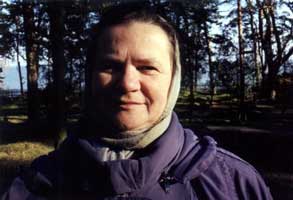|
Kurische
Nehrung
|
Volker
Koepp
|
|
Deutschland
2001
|
 |
 |
| Delphi-Filmpalast 10.02
16.45 CinemaxX 3 11.02 10.00 CineStar 8 11.02 19.30 Kino Arsenal 13.02 13.15 Babylon 15.02 19.00 |
| Produktion: Thomas Geyer
Film/Vineta Film, SWR, ARTE Weltvertrieb: Thomas Geyer Film/Vineta Film Ahrenshooper Zeile 51, D-14129 Berlin Tel. (49-30) 8090 8084, Fax: 802 98 59 Buch: Volker Koepp Kamera: Thomas Plenert Ton: Matthias Pfister, Uve Haussig Redaktion: Ulrike Becker, Ebbo Demant Format: 35mm, 1:1.66, Farbe Länge: 92 Minuten, 24 Bilder/Sek. Sprachen: Deutsch, Russisch, Litauisch |
| Dort an sarmatischen Ufern: Die Memel fällt durch
ein Delta ins Kurische Haff. Vom Meer, der Ostsee, ist das Haff durch
die Kurische Nehrung getrennt. Diese wundersame Landzunge ist hundert
Kilometer lang und oft nur ein paar hundert Meter breit. Der Himmel
wölbt sich hoch, zwischen Kiefern und Birken hat der Wind riesige
Wanderdünen vor sich hergeschoben. Der Sand hat manche Orte verschluckt,
erst seit etwas mehr als hundert Jahren stehen die Dünen durch
Bepflanzung. Besiedlung durch Kuren und Deutsche. Nach dem Ersten
Weltkrieg wird der nördliche Teil litauisch und nach dem Zweiten
Weltkrieg der südliche russisch. Auch die neuangesiedelten Menschen
lebten meist vom Fischfang. Und jedes Jahr wieder gibt es die großen
Vogelzüge über die Nehrung. Die Orte des Filmes heißen
Rybatschi (Rossitten) und Nida (Nidden). Dort leben heute vor allem
Russen und Litauer, ein paar Deutsche sind im litauischen Teil der
Nehrung geblieben. „Diese Art von Dokumentarfilm weist Strukturen auf, die quer zur allgemeinen Entwicklung stehen. Filme werden heute immer schneller. Offenbar glaubt man, sich nicht die Zeit für einen Menschen nehmen zu können, wenn er beispielsweise gerade nichts sagt. Man nimmt sich keine Zeit, Landschaften zu betrachten. Insofern verweigert sich mein Film diesem Trend. Und dann hat dieser Dokumentarfilm wirklich etwas Subversives, nämlich seine langsame Gangart.“ Volker Koepp |
Up there on the Sarmatian shores, the River Neman flows
through a delta to the Curonian Lagoon. The lagoon is separated from
the sea, the Baltic, by the Curonian Spit. This wonderful promontory
is a hundred kilometres long and often no more than a few hundred
metres wide. The sky arches upwards, the wind has blown enormous drifting
sand dunes ahead of itself between pine and birch trees. The sand
has swallowed up entire settlements. The dunes have only been halted
for just over a century by planting vegetation. The area has been
settled by Curonians and Germans. After the First World War the northern
part of the Curonian Spit became Lithuanian, and after the Second
World War the southern half became Russian. Even recent settlers mainly
live off fishing. And year after year, huge flocks of birds fly over
the spit. The film takes place in Ribachi and Nida. Today they are
inhabited mainly by Russians and Lithuanians, though a few Germans
have remained in the Lithuanian part of the spit. “This kind of documentary has structures which run contrary to the general trend. Films are becoming faster on the whole. Film-makers obviously think they can’t take time for people when they aren’t saying something, for example. They don’t take the time to look at scenery. As such my film refuses to follow the general trend. And then this documentary really has something subversive, namely its slow progression.“ Volker Koepp |
| Volker Koepp, geb. 1944 in Stettin. Nach dem Filmstudium Regisseur am DEFA-Studio für Dokumentarfilm. Filme seit 1971, im Forum u.a. Mädchen in Wittstock (1977), Kalte Heimat (1995), Wittstock, Wittstock (1997), Herr Zwilling und Frau Zuckermann (1999). |